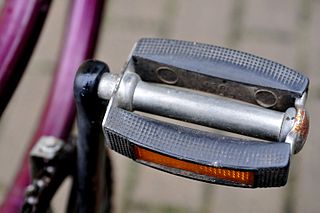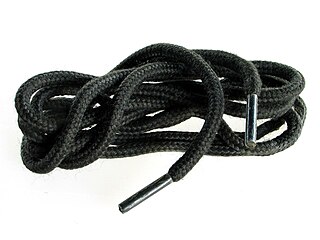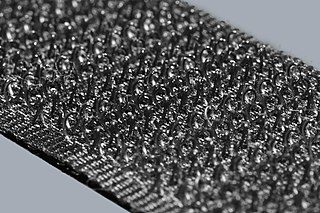Related Research Articles

Computer data storage or digital data storage is a technology consisting of computer components and recording media that are used to retain digital data. It is a core function and fundamental component of computers.

A clutch is a mechanical device that allows an output shaft to be disconnected from a rotating input shaft. The clutch's input shaft is typically attached to a motor, while the clutch's output shaft is connected to the mechanism that does the work.

A hard disk drive (HDD), hard disk, hard drive, or fixed disk is an electro-mechanical data storage device that stores and retrieves digital data using magnetic storage with one or more rigid rapidly rotating platters coated with magnetic material. The platters are paired with magnetic heads, usually arranged on a moving actuator arm, which read and write data to the platter surfaces. Data is accessed in a random-access manner, meaning that individual blocks of data can be stored and retrieved in any order. HDDs are a type of non-volatile storage, retaining stored data when powered off. Modern HDDs are typically in the form of a small rectangular box.

In computing, magnetic-core memory is a form of random-access memory. It predominated for roughly 20 years between 1955 and 1975, and is often just called core memory, or, informally, core.

The pedal is the part of a bicycle that the rider pushes with their foot to propel the vehicle. It provides the connection between the cyclist's foot or shoe and the crank allowing the leg to turn the bottom bracket spindle and propel the bicycle's wheels. A pedal usually consists of a spindle that threads into the end of the crank, and a body on which the foot rest is attached, that is free to rotate on bearings with respect to the spindle.

A zipper, zip, zip fastener (UK), formerly known as a clasp locker, is a commonly used device for binding together two edges of fabric or other flexible material. Used in clothing, luggage and other bags, camping gear, and many other items, zippers come in a wide range of sizes, shapes, and colors. In 1892, Whitcomb L. Judson, an American inventor from Chicago, patented the original design from which the modern device evolved.
Magnetoresistive random-access memory (MRAM) is a type of non-volatile random-access memory which stores data in magnetic domains. Developed in the mid-1980s, proponents have argued that magnetoresistive RAM will eventually surpass competing technologies to become a dominant or even universal memory. Currently, memory technologies in use such as flash RAM and DRAM have practical advantages that have so far kept MRAM in a niche role in the market.

An aglet or aiglet is a small sheath, often made of plastic or metal, attached at each end of a shoelace, a cord, or a drawstring. An aglet keeps the fibers of the lace or cord from unraveling; its firmness and narrow profile make it easier to hold and easier to feed through eyelets, lugs, or other lacing guides.

Shoelaces, also called shoestrings or bootlaces, are a system commonly used to secure shoes, boots, and other footwear. They typically consist of a pair of strings or cords, one for each shoe, finished off at both ends with stiff sections, known as aglets. Each shoelace typically passes through a series of holes, eyelets, loops or hooks on either side of the shoe. Loosening the lacing allows the shoe to open wide enough for the foot to be inserted or removed. Tightening the lacing and tying off the ends secures the foot firmly within the shoe. The laces can be tied in different shapes, most commonly a simple bow.
IBM manufactured magnetic disk storage devices from 1956 to 2003, when it sold its hard disk drive business to Hitachi. Both the hard disk drive (HDD) and floppy disk drive (FDD) were invented by IBM and as such IBM's employees were responsible for many of the innovations in these products and their technologies. The basic mechanical arrangement of hard disk drives has not changed since the IBM 1301. Disk drive performance and characteristics are measured by the same standards now as they were in the 1950s. Few products in history have enjoyed such spectacular declines in cost and physical size along with equally dramatic improvements in capacity and performance.
Adaptive clothing is clothing designed around the needs and abilities of people with varying degrees of disability, including congenital disabilities, acquired disabilities, age and temporary disabilities, as well as physical disabilities. Adaptive clothing is influenced by factors such as age, disability type, level of independence, mobility and dexterity, as well as whether a person requires help when dressing, such as from a caregiver. People who struggle with zippers, shoelaces, buttons or even fabrics and texture due to a type of disability may need adaptive clothing. Most adaptive clothing designs are taken from general-market clothing, the comfort of which began to increase in the 1950s, with new technologies such as elastic waistbands and stretchy fabrics.

A nipple clamp is a type of sex toy that is applied to a person's nipples to pinch them. Varieties of nipple clamp include clothes-pin-style, tweezer and clover. Nipple clamps are used to cause pain in the nipples as part of certain BDSM activities. They are also used to produce erotic stimulation as part of nipple play. In this context they are not primarily used to produce pain but rather to increase nipple sensation. Their use traps blood in the nipples, increasing the sensitivity of the nipple. The sexologist Carol Queen says that "clamps are also very useful for hands-free nipple play".

A magnetic track brake is a brake for rail vehicles. It consists of brake magnets, pole shoes, a suspension, a power transmission and, in the case of mainline railroads, a track rod. When current flows through the magnet coil, the magnet is attracted to the rail, which presses the pole shoes against the rail, thereby decelerating the vehicle.
Racetrack memory or domain-wall memory (DWM) is an experimental non-volatile memory device under development at IBM's Almaden Research Center by a team led by physicist Stuart Parkin. It is a current topic of active research at the Max Planck Institute of Microstructure Physics in Dr. Parkin's group. In early 2008, a 3-bit version was successfully demonstrated. If it were to be developed successfully, racetrack memory would offer storage density higher than comparable solid-state memory devices like flash memory.

Radionics—also called electromagnetic therapy (EMT) and the Abrams method—is a form of alternative medicine that claims that disease can be diagnosed and treated by applying electromagnetic radiation (EMR), such as radio waves, to the body from an electrically powered device. It is similar to magnet therapy, which also applies EMR to the body but uses a magnet that generates a static electromagnetic field.

The shoelace knot, or bow knot, is commonly used for tying shoelaces and bow ties.
Solid-state storage (SSS) is non-volatile computer storage that has no moving parts; it uses only electronic circuits. This solid-state design dramatically differs from the commonly-used competing technology of electromechanical magnetic storage which uses moving media coated with magnetic material. Generally, SSS is much faster but more expensive for the same amount of storage.

Hook-and-loop fasteners, commonly known as Velcro, hook-and-pile fasteners or touch fasteners are versatile fastening devices that allow two surfaces to be repeatedly attached and detached with ease. Invented in the mid-20th century, they are widely used in clothing, accessories, and various industrial and consumer applications. The fastener consists of two complementary components: one with tiny hooks and the other with soft loops. When pressed together, the hooks catch the loops, creating a secure but temporary bond. The fasteners can be separated by peeling or pulling the surfaces apart, often producing a distinctive ripping sound.
The term digital card can refer to a physical item, such as a memory card on a camera, or, increasingly since 2017, to the digital content hosted as a virtual card or cloud card, as a digital virtual representation of a physical card. They share a common purpose: identity management, credit card, debit card or driver's license. A non-physical digital card, unlike a magnetic stripe card, can emulate (imitate) any kind of card.

String is a long flexible structure made from fibers twisted together into a single strand, or from multiple such strands which are in turn twisted together. String is used to tie, bind, or hang other objects. It is also used as a material to make things, such as textiles, and in arts and crafts. String is a simple tool, and its use by humans is known to have been developed tens of thousands of years ago. In Mesoamerica, for example, string was invented some 20,000 to 30,000 years ago, and was made by twisting plant fibers together. String may also be a component in other tools, and in devices as diverse as weapons, musical instruments, and toys.
References
- ↑ Coxworth, Ben (11 October 2014). "Zubits are designed to make shoe-tying obsolete". newatlas.com.
- ↑ "Gear review: Zubits Magnetic Shoe Closures". The Denver Post. 11 March 2016.